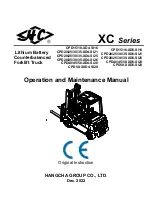
Handling the BT DPF-II System (Option)
© BT Industries AB 180424-040
41
Instrument inspection
•
Start the engine and see that they operate properly.
Fuel level check and supply
1.
Observe the fuel meter to see if the fuel is sufficient.
Note:
After the end of daily operation, fill the tank with fuel to prevent
the moisture in the air in the tank from mixing into the fuel.
2.
When supplying fuel, stop the engine, remove the fuel tank
cap by turning it counterclockwise, and pour fuel through the
fuel filler neck.
3.
After fueling, be sure to tighten the fuel tank cap.
CAUTION!
• Always stop the engine and keep any fire source away before
and during the fueling operation.
• Carefully prevent entrance of water and dirt into the tank dur-
ing fueling.
Engine inspection
•
Start the engine and warm it up sufficiently.
1.
Check each meter and warning lamp to see there is no
abnormality.
2.
Check if the engine is generating abnormal sound or vibra-
tion.
3.
Check the exhaust gas color to see it is normal.
Colorless or light blue exhaust indicates complete combus-
tion; black exhaust, incomplete combustion; and white
exhaust, burning oil as a result of oil getting into the cylin-
ders.
WARNING!
• The exhaust gas is harmful. If you must start the engine
inside a building or enclosure, insure sufficient ventilation.
• The gasoline engine carburetor is equipped with the auto-
matic choke that keeps the engine running at a relatively high
speed a while. Do not be bothered, however, becomes the
engine resumes a normal speed upon warming enough.
1 Fuel tank
































